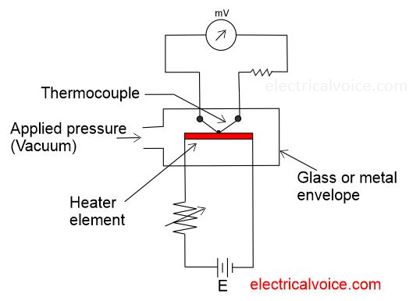Thermocouple Vacuum gauge is a device that is used for the measurement of pressure in vacuum systems or in the very low-pressure region (below atmospheric pressure). The working of this gauge depends upon the variation of thermal conductivity of a gas with pressure. The ability of a material to carry heat by conduction is called thermal conductivity. In other words, we can say that thermocouple vacuum gauge measures pressure by measuring the change in the ability of a gas to conduct heat.
Measurement of Pressure
The thermocouple vacuum gauge consists of the heater element and a thermocouple. Both the heater element and the thermocouple are housed in a glass or metal envelope as shown in figure 1. The thermocouple junction makes contact with the heater element. The heater element is heated by a constant current supplied by the source.

Working Principle
A heater element gets heated when electric current flows through it. The rate at which heat is dissipated from this heater element depends on the thermal conductivity of the surrounding medium. The thermal conductivity of the surrounding medium, in turn, depends on the density of the surrounding medium.
If the density of the surrounding medium is high then its thermal conductivity also will be high. This will cause the element to dissipate heat faster and hence the temperature of the element is low for a given current flow.
If the density of the surrounding medium is low then its thermal conductivity also will also be low. This will cause the element to dissipate heat slower and hence the temperature of the element is high for a given current flow.
When a constant current is allowed to flow through the heater element, the temperature of the element increases. Now the pressure to be measured (i.e. applied pressure) is applied to the gauge chamber as shown in figure 1. Due to the applied pressure, the density of the surrounding medium (gas in this case) of the heater element changes.
Due to this change in density of the surrounding medium (gas in this case) of the filament, its thermal conductivity changes causing the temperature of the heater element to change.
The temperature depends upon the rate at which heat is lost to the surrounding medium. This temperature is sensed by the thermocouple junction. At low pressure, the temperature is a function of pressure. The temperature sensed by the thermocouple junction, provided by the thermocouple output voltage. Since the thermocouple output voltage is proportional to the junction temperature and the junction temperature is a function of pressure. Hence thermocouple output voltage is a function of pressure. The moving coil instrument (voltmeter) can be used to calibrate to read the pressure.
Advantages
1. It is inexpensive.
Disadvantages
1. There is a chance of burning of the gauge if the atmospheric pressure is applied when the heater element is hot.
2. These gauges are not accurate instruments.
